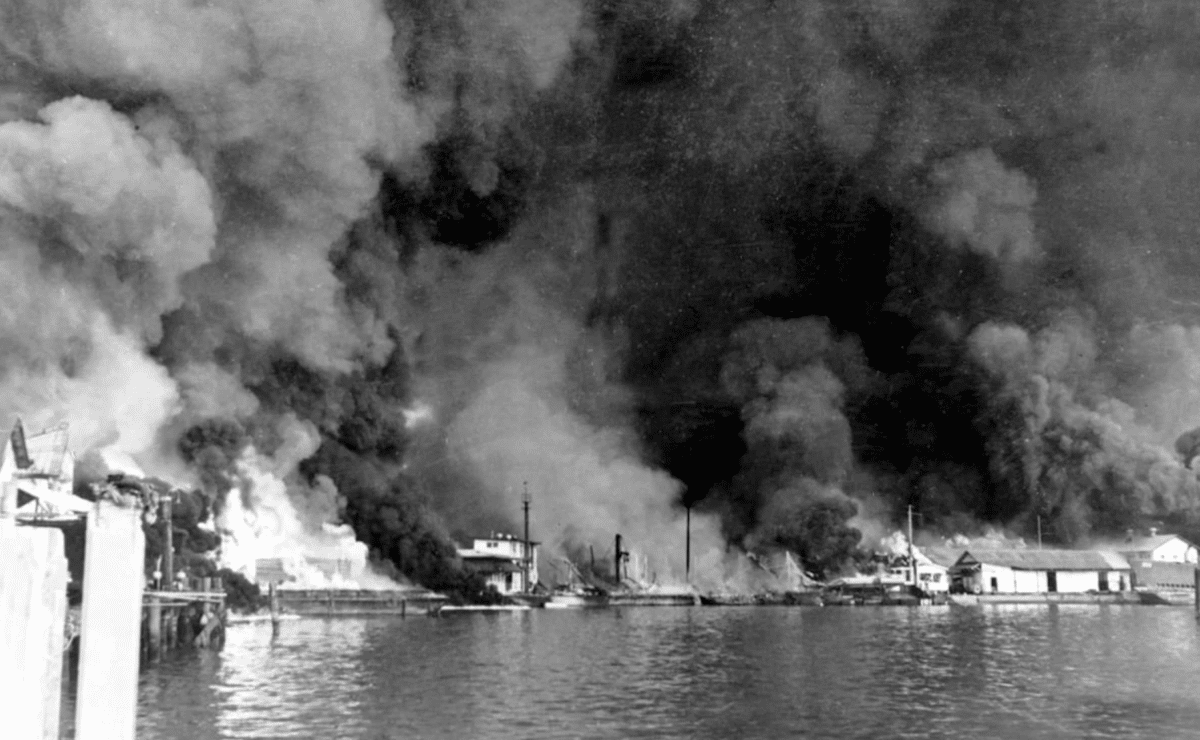December 7, 1941: Attack on Pearl Harbor by the Imperial Japanese Navy

The Cavite navy yard under attack in December 1941. Photo from the US Naval Institute
By December 7, 1941, the chances of resolving the many disputes between Japan and the United States were negligible. The American military leadership in Hawaii knew that fighting could commence at any time.
Unfortunately, the senior military leadership did not react and prepare for an attack early enough. With minimal opposition, the Japanese Imperial Navy killed or wounded approximately four thousand American sailors and soldiers on December 7, 1941. Many American ships were sunk and damaged. Fortunately, three American aircraft carriers were conducting maneuvers at sea away from Pearl Harbor.
Following the destruction at Pearl Harbor, the commanding Japanese admiral, Isoroku Yamamoto, stated to his subordinate officers that “I fear we have only awakened a sleeping giant.” His words would prove to be perceptive.
The day after the attack, President Franklin D. Roosevelt addressed a joint session of Congress, He called December 7, 1941, as “…a day that will live in infamy.” The United States Congress declared war on Imperial Japan. Shortly, Nazi Germany and Fascist Italy, who were allied with Japan, declared war on the United States. The United States had finally entered World War II.
The Americans who died or were wounded at Pearl Harbor should always be memorialized for their bravery and service.
However, we seem to forget the Americans and Filipinos who died or were wounded in the Philippines shortly after the attack on Pearl Harbor. The Americans and Filipinos should also be memorialized for their service.
Within hours after the attack on Pearl Harbor, the Philippine bases at Cavite navy yard, Clark Field, Iba Field and Nichols Field were devastated by Japanese aircraft from Taiwan. Most of the modern B-17 bombers and the P-40 fighter planes were destroyed. This catastrophe contributed to the eventual defeat of American and Filipinos forces on Bataan and Corregidor.
Unlike Pearl Harbor, the American Naval and Army leadership in the Philippines had intelligence that the Japanese had attacked Hawaii. The Philippines received the intel at 3 a.m. on December 8, 1941. The American leadership in the Philippines have been criticized for not taking decisive action once they received the news.
There is an argument by some historians that the American War Department and the Roosevelt Administration abandoned the Philippines in favor of Europe first. When you read Brigadier General Dwight D. Eisenhower’s diary from mid-December 1941 to mid-June 1942, most of his focus was on the Philippines. Beginning on December 14, 1941, Eisenhower was the Head of the War Planning Department for the Philippines and the Far East.
The issue was not abandonment. The problem was the devastation at Pearl Harbor. The Pre-War Planning for protecting the Philippines counted on reinforcements and resupply from Pearl Harbor. A rescue armada from Hawaii was not happening anytime soon. If Pearl Harbor was not destroyed, the Japanese still controlled the sea lanes from Honolulu to Manila.
Dennis Edward Flake is the author of three books on Philippine-American history. He is a Public Historian and a former park ranger in interpretation for the National Park Service at the Eisenhower National Historic Site in Gettysburg, PA. He can be contacted at: flakedennis@gmail.com

